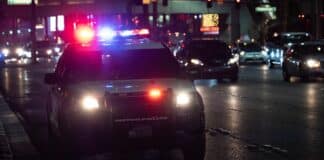Yellowknife, the capital of Canada’s Northwest Territories, finds itself in the path of a relentless fire that’s forced thousands of residents to flee, The Associated Press reports.
With the blaze inching closer to the city, emergency measures are in full swing.
“We’re heading into a critical couple of days,” commented Shane Thompson, a government official of the Territories, addressing the media about the dire situation.
Royal Canadian Mounted Police (RCMP) in Yellowknife said a fire started in Long Lake on Tuesday has been determined to be arson.
“The cause of the fire has been determined to be arson,” The NWT RCMP said. “A witness in the area reported seeing two men running from the area wearing black clothing.”
Firefighters and emergency teams are fervently trying to ensure a safe passage for residents looking to evacuate by the stipulated deadline of noon on Friday.
Aerial firefighting operations, aided by airtankers, were active throughout the night to keep the highway out of Yellowknife operational.
Furthermore, extensive protective measures such as fire guards, sprinklers, and water cannons are being set up around the city.
The situation is exacerbated by the prevailing northwest winds and inadequate rainfall.
Officials hope for some respite with a chance of light rain on Friday, but they believe it might not be sufficient to thwart the fire’s advance.
The fire, presently 15 kilometers (9 miles) away, is predicted to reach city limits by the weekend.
Thousands have already sought safety, either traveling hundreds of kilometers or boarding emergency flights.
Highlighting the scale of the evacuation, Jennifer Young of the Northwest Territories’ Department of Municipal and Community Affairs reported, “Ten planes left Yellowknife with 1,500 passengers on Thursday,” and optimistically added hopes for “22 flights to leave Friday with 1,800 more passengers.”
Yellowknife Mayor Rebecca Alty provided a glimmer of hope saying the fire’s advance on Thursday wasn’t as swift as anticipated, but quickly added, “it is still coming.”
The looming threat of thick smoke has made evacuations all the more pressing.
Residents like Alice Liske, who evacuated with her six children due to the deteriorating air quality, voiced concerns: “Not only that,” she said, “but when we go back, what will be there for us?”
It’s worth noting that Canada is grappling with its most severe fire season on record.
Data from the Canadian Interagency Forest Fire Centre shows over 5,700 fires have consumed more than 137,000 square kilometers (53,000 square miles) across the country.
As of now, over 1,000 fires rage nationwide, with more than half being uncontrollable.
In regions south of Yellowknife, including West Kelowna in British Columbia, evacuation orders have been issued due to nearby fires.
But the magnitude of the Yellowknife evacuation surpasses any this year, remarked Ken McMullen, President of the Canadian Association of Fire Chiefs, emphasizing the urgency, “It’s one of those events where you need to get people out sooner rather than later.”
Prime Minister Justin Trudeau convened with his incident response team, urging ministers to maintain communication services.
He emphasized, “there would be no tolerance for price gouging on flights or essential goods.”
A testimony to the mass exodus was evident at the Big River Service Station, situated 300 kilometers (185 miles) south of Yellowknife.
Employee Linda Croft described the scene, saying, “You can’t see the end of it.” as she referred to the lengthy queue of vehicles waiting for fuel.





